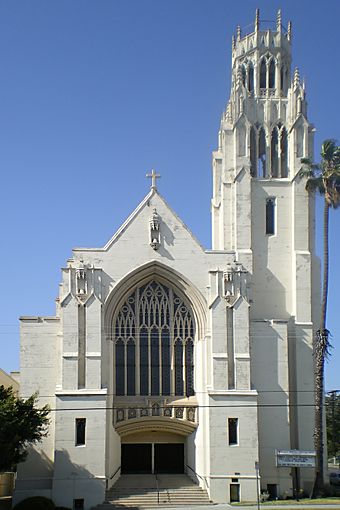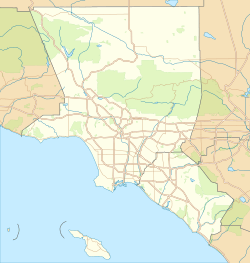McCarty Memorial Christian Church facts for kids
Quick facts for kids |
|
|
McCarty Memorial Christian Church
|
|
 |
|
| Location | 4101 West Adams Boulevard Los Angeles, California |
|---|---|
| Built | 1932 |
| Architect | Barber, Thomas P.; Kingsbury, Paul |
| Architectural style | Late Gothic Revival |
| NRHP reference No. | 01001456 |
| Added to NRHP | January 17, 2002 |
The McCarty Memorial Christian Church is a beautiful old church in Los Angeles, California. It is located in the West Adams neighborhood. This church was built in 1932 and looks like churches from the Gothic period. It belongs to the Christian Church (Disciples of Christ).
The church became well-known in the 1950s. It was one of the first churches in its area to welcome people of all races. This was a very important step for the community.
Contents
Church Design and Style
The McCarty Memorial Christian Church was built in 1932. Its design is called English Gothic Revival. This style brings back the look of medieval European churches.
The church has many special features. It has amazing stained glass windows. These windows show detailed patterns called Gothic tracery. The church also has arcaded ambulatories. These are walkways with arches, often found around the main part of a church.
A tall, 130-foot tower stands out. It has an open belfry at the top, where bells are kept. This tower is a landmark in the area.
In January 2002, the church was added to the National Register of Historic Places. This list includes buildings that are important to American history. A few months later, the church received a "Preserve L.A." grant. This money helped them plan how to keep the church in good condition for the future. Experts say the church is a great example of concrete churches built in Los Angeles during the late 1920s.
Church History
Building the Church
Dr. and Mrs. Isaac A. McCarty paid for the church to be built. They had traveled a lot, studying church designs. They wanted to build a special place for their community.
The church was officially opened in May 1932. This was also the McCartys' 45th wedding anniversary. The Los Angeles Times newspaper reported that the church cost $250,000 to build. The land it was on cost another $30,000. Dr. McCarty even brought many parts of the church's inside from Czechoslovakia.
The newspaper called the church "one of the finest examples of pure Gothic architecture in America." It was designed by architects Thomas P. Barber and Paul Kingsbury. Important people, like Los Angeles Mayor John Porter, attended the opening ceremony. Dr. McCarty passed away two years later in May 1934. His funeral was held in the church he helped create.
The first pastor was Dr. Bruce Brown. He led the church until 1942. After him, Dr. O. James Sowell was pastor from 1942 to 1952. The Rev. James Clark Brown then served for a short time.
Welcoming Everyone: Integration
The Rev. Kring Allen became the pastor in 1954. He is remembered for successfully making McCarty Church a place for everyone. At that time, many neighborhoods were changing. The church's area became home to many different people.
When Rev. Allen arrived, the church had fewer members than before. He had a plan that was quite new for the time. He believed the church should welcome people of all backgrounds. He told his church leaders that the church needed to be integrated, or he would not stay.
Rev. Allen spent time learning about different cultures. He wanted to understand people better. He knew that making the church integrated would be challenging. Some people wanted to keep things separate. But Rev. Allen believed that welcoming everyone was a core part of the church's message.
A turning point happened when Rev. Allen took 70 church members, both black and white, to a camp. They lived, worked, and studied together. This experience helped them become a strong, united group. They returned to the church as a fully integrated team. Rev. Allen became a strong supporter of integration in churches. He believed that churches must welcome everyone to truly follow their mission.
See also
People
- Don A. Allen, a member of the California State Assembly and the Los Angeles City Council, attended McCarty Memorial.




